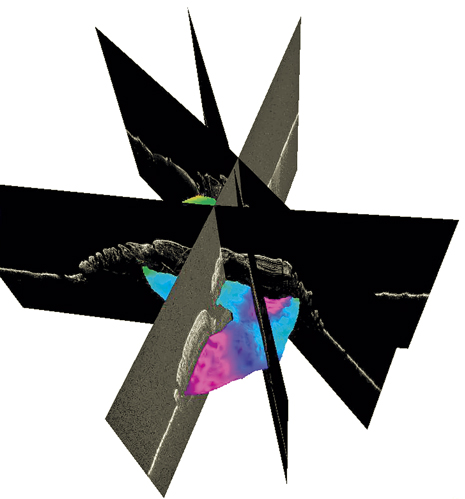Innovative thinkers
Celestial seismic: 3D interpretation unlocks Martian mysteries
|
Researchers may be close to identifying one of the simplest forms of life on Mars—the presence of carbons. With the use of the Mars Reconnaissance Orbiter (MRO), Calgary-based seismic software company Seisware, in partnership with NASA, has launched the world’s first 3D subsurface data recovery and processing (seismic or radar) in outer space for the polar caps on Mars. In doing so, the firm has moved the latest generation of seismic technology into deep outer space.
Planum Boreum is a permanent, 375-mi-radius, northern Polar ice cap, containing carbon dioxide and water, located amid the vast 930 sq mi of lowlands on Mars. The area was first documented successfully in 2008, and is theorized to be around 1.85 mi deep. Aside from understanding the composition of this unique formation better, and its implication for possible signs of life on the planet, scientists have been working to correlate the formation’s composition to the weather patterns that loom over the north pole of Mars. In doing so, researchers hope to understand more about the Red Planet’s history, and how changes in climate affect carbon formations. To identify and map the subsurface features of the region, Seisware partnered with the NASA’s Mars Data Analysis Program, to launch an MRO that orbits Mars every hour and records shallow radar (SHARAD) observation of the polar caps’ layers. Traveling at an orbital altitude of 255–320 km, the system transmits data in 5-25-MHz lateral resolution. More than 2,500 2D radar images have been taken by the MRO and processed by SHARAD. These have been analyzed by Dr. Than Putzig, senior research scientist at the Southwest Research Institute Department of Space Studies, and system scientist for CO-SHARPS, the Colorado SHARAD Processing System. Based on the data collected, Seisware has successfully converted a test set of SHARAD observations into a 3D interpretation within a commercial processing environment. Also, given the high number of radar images taken by the MRO, the coverage of Planum Boreum, with time, became dense enough to allow treatment of the 2D observations as a 3D data set. Whereas a conventional 2D cross-section of a 3D model produces a high volume of clutter and interferences, data in a 3D volume migration processing repositions off-nadir signals to their source location. This technique, which includes binned migration algorithms, reduces clutter and provides for a clearer, more detailed image of the mapped area’s subsurface. Additionally, because radar travels at a different velocity through ice-rich subsurface formations, and given the fact that Mars’ ionosphere distorts and delays radar signals, it is even more imperative that accurate imaging methods are employed to provide accurate geological mapping. Seisware’s initial data from SHARAD shows three distinct geological layers within Planum Boreum—basaltic sand dunes, ice-rich layered deposits and layer-exposing troughs. The program’s radar has penetrated the formation’s base and revealed deflection low enough to require either a 300-km-thick lithosphere or unusually high mantle viscosity. A set of interpretations has also revealed something very promising—signs of water on the planet. Seisware software has mapped a large deposit of CO2, and ground samples taken by NASA’s Mars rover, Curiosity, have shown rounded pebbles and rocks, indicating that a stream once ran through the area. With a new round of funding approved, Seisware plans to apply 3D migration to all Planum Boreum observations, which will map out further geological and subsurface formations. The program hopes that this detailed data will shed light on the nature and timing of the polar layered deposits at both poles, coming one step closer to decoding the past climatic conditions and helping to solve the mystery of existence of Martian life. |
- Prices and governmental policies combine to stymie Canadian upstream growth (February 2024)
- U.S. producing gas wells increase despite low prices (February 2024)
- U.S. drilling: More of the same expected (February 2024)
- U.S. oil and natural gas production hits record highs (February 2024)
- U.S. upstream muddles along, with an eye toward 2024 (September 2023)
- Canada's upstream soldiers on despite governmental interference (September 2023)
- Applying ultra-deep LWD resistivity technology successfully in a SAGD operation (May 2019)
- Adoption of wireless intelligent completions advances (May 2019)
- Majors double down as takeaway crunch eases (April 2019)
- What’s new in well logging and formation evaluation (April 2019)
- Qualification of a 20,000-psi subsea BOP: A collaborative approach (February 2019)
- ConocoPhillips’ Greg Leveille sees rapid trajectory of technical advancement continuing (February 2019)



